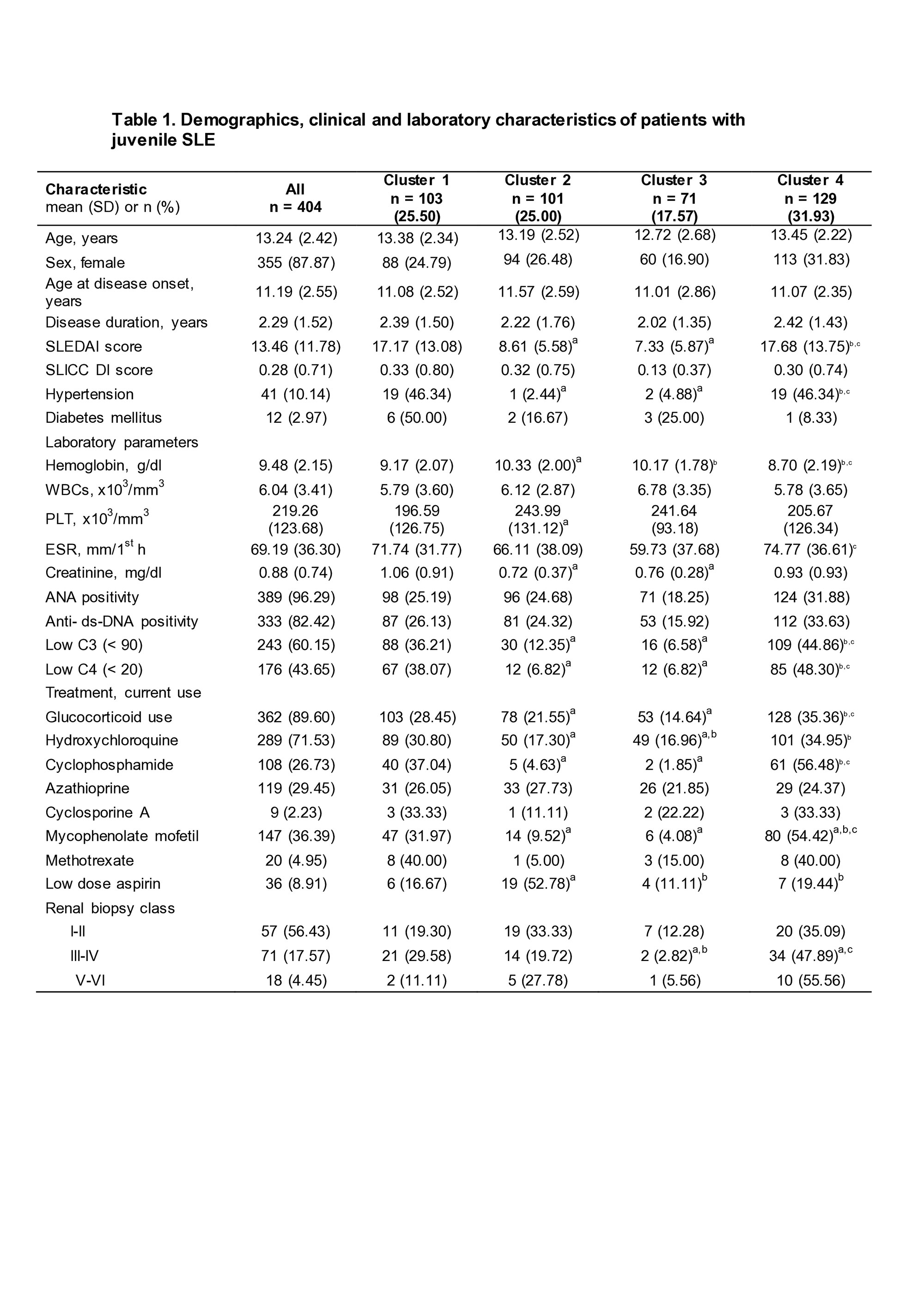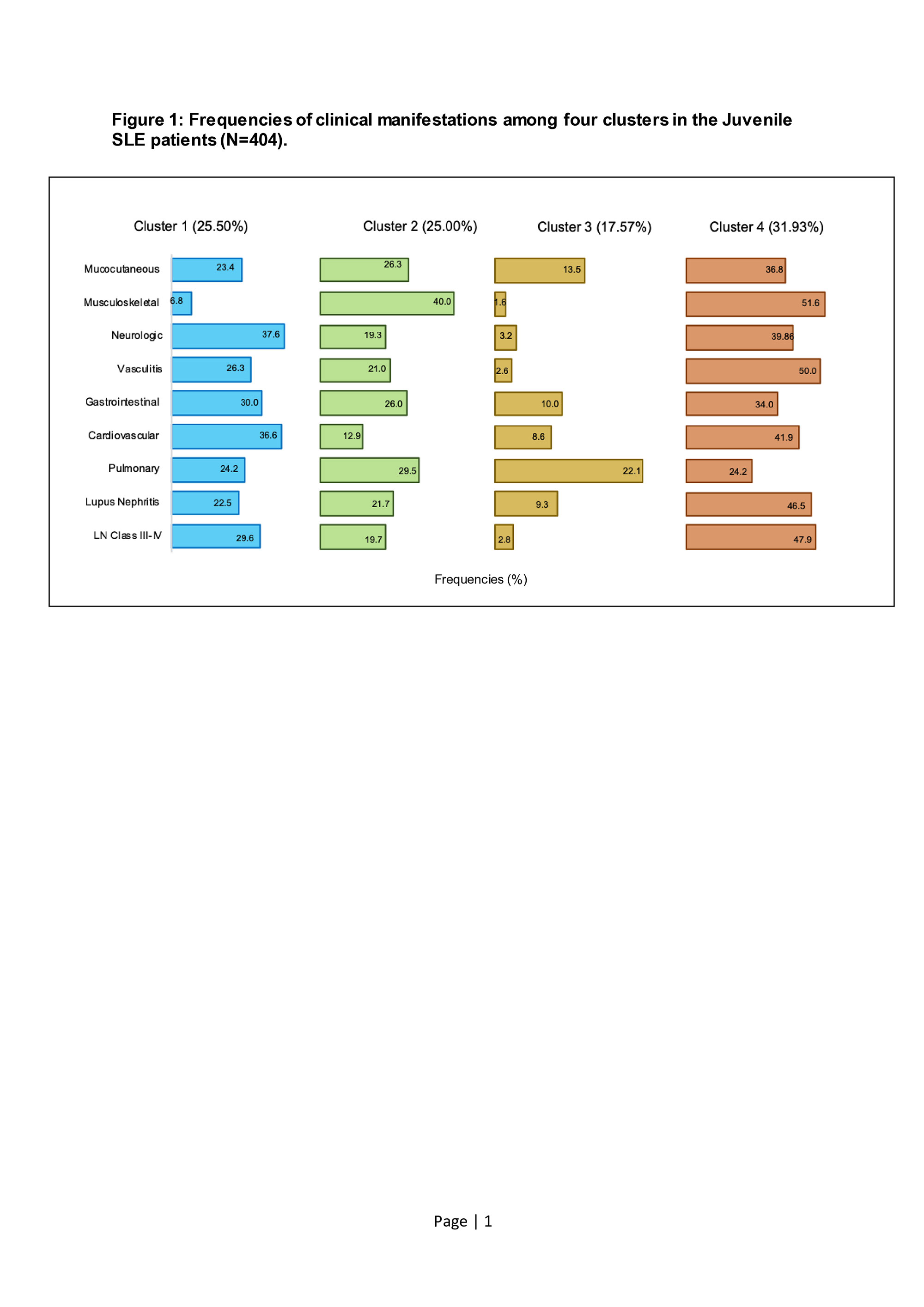Session Information
Date: Saturday, November 12, 2022
Title: SLE – Diagnosis, Manifestations, and Outcomes Poster I: Diagnosis
Session Type: Poster Session A
Session Time: 1:00PM-3:00PM
Background/Purpose: Juvenile systemic lupus erythematosus (J-SLE) is a complex autoimmune disease characterized by a great heterogeneity in organs involvement. A better understanding of the organ involvement patterns in patients with J-SLE may facilitate making accurate individualized management decisions. Therefore, we examined the clinical patterns of organ manifestations in patients with J-SLE by using cluster analysis and compared the frequency of various clinical features including lupus nephritis (LN), laboratory variables, and immunosuppressive therapies among these clusters of patients.
Methods: Patients (≤18 years) have a confirmed diagnosis of J-SLE by SLICC classification criteria were identified from the clinical database of the Egyptian College of Rheumatology (ECR) SLE study group (Eesa NN, et al. Lupus 2021). The demographic data, clinical characteristics, disease activity score, disease damage index, autoantibodies, and current therapies were selected. Patients were divided into groups by using the K-mean cluster analysis. After clustering, distinct J-SLE subtypes were identified and then validated by detecting significant differences across clusters. The Chi-square test was used for categorical variables and one-way ANOVA for continuous measures.
Results: Overall, 404 patients (355 (87.9%) female, mean age at diagnosis 11.2 years; mean disease duration 2.3 years) were included. Four distinct subsets of patients were identified with the characteristics of patients in each of these clusters summarized in Table 1, including the inter-cluster differences. The demographic characteristics and disease duration were comparable between groups (p > 0.05). Patients in cluster 1 (n=103, 25.5%) were characterized predominantly by mucocutaneous and neurologic manifestations. Patients in cluster 2 (n=101, 25.0%) were more likely to have arthritis and pulmonary manifestations. Cluster 3 was the smallest group (n=71, 17.6%), and patients in this group had the lowest prevalence of arthritis and LN, indicative of mild disease intensity. Patients in cluster 4 (n=129, 31.9%) have the highest prevalence of arthritis, vasculitis, renal involvement, and proliferative LN, Figure 1. The severity of the disease was different across clusters; patients in clusters 1 and 4 had the highest systemic lupus erythematosus disease activity index score, and lowest complement level, and were significantly less likely to use low dose aspirin (LDA). We found that autoantibodies positivity and SLE damage score were comparable across clusters.
Conclusion: We describe a large cohort of J-SLE and identify four distinct subgroups of patients using cluster analysis. The use of LDA appears to be associated with a mild severity form of the disease. Clustering analysis might help to implement targeted therapy for various disease subsets in heterogenous diseases like lupus. Further research to better understand the mechanistic pathways underlying different clinical phenotypes is needed.
Acknowledgment: The authors are grateful for Amany S El-Bahnasawy, Marwa ElKhalifa, Emad El-Shebini, Samah I Nasef, Nermeen Noshy, Nermeen Samy, Nouran M Abaza, Eman F Mohamed, Mohamed N Salem, Ahmed M Abdalla, Esam Abualfadl.
a Significantly different from cluster 1, b Significantly different from cluster 2, c Significantly different from cluster 3.
To cite this abstract in AMA style:
Hammam N, Bakrey Mahmoud M, Bakhiet A, El Owaidy R, Abdel Nabi H, M Elsaman A, Khalifa I, M NourEl-Din A, R ElShereef R, Hassan E, Ismail F, I El-Gazzar I, Moshrif A, M Khalil N, A Amer M, M Fathy H, Abdel Salam N, Tharwat S, I Abd Elazeem M, M Fathi H, Gheita T. Identifying Distinct Phenotypes of Patients with Juvenile Systemic Lupus Erythematosus: Results from a Cluster Analysis by the Egyptian College of Rheumatology (ECR) Study Group [abstract]. Arthritis Rheumatol. 2022; 74 (suppl 9). https://acrabstracts.org/abstract/identifying-distinct-phenotypes-of-patients-with-juvenile-systemic-lupus-erythematosus-results-from-a-cluster-analysis-by-the-egyptian-college-of-rheumatology-ecr-study-group/. Accessed .« Back to ACR Convergence 2022
ACR Meeting Abstracts - https://acrabstracts.org/abstract/identifying-distinct-phenotypes-of-patients-with-juvenile-systemic-lupus-erythematosus-results-from-a-cluster-analysis-by-the-egyptian-college-of-rheumatology-ecr-study-group/


